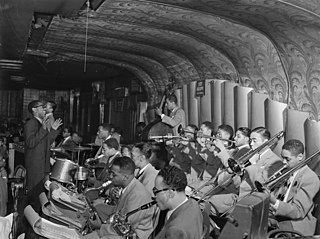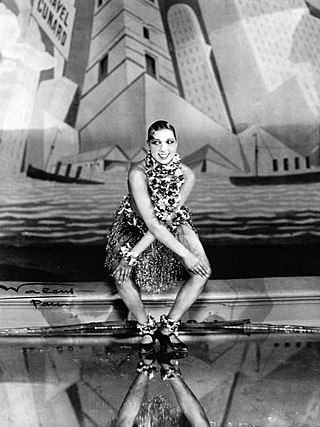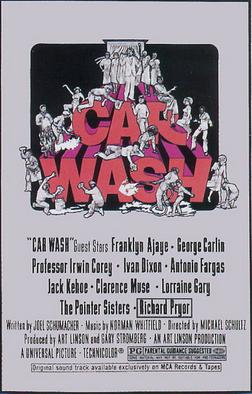External links
- Al Minns / Leon James on Streetswing.com
- Al & Leon search on YouTube featuring samples of their work
Al & Leon were a prominent American Lindy Hop and jazz dance duo. The two members were Al Minns and Leon James. They were most famous for their film and stage performances in the 1930s and 1940s both on their own, and as part of the Harlem-based Whitey's Lindy Hoppers. They appeared in the Marx Brothers film A Day at the Races. They also appeared on US television programs in the 1950s and 1960s, highlighting the jazz dances they and their cohorts helped to pioneer at the Savoy Ballroom in New York, as well as working throughout their lives to promote the dances to new generations.
Jazz dance is a performance dance and style that arose in the United States in the mid 20th century. Jazz dance may allude to vernacular jazz about to Broadway or dramatic jazz. The two types expand on African American vernacular styles of dance that arose with jazz music. Vernacular jazz dance incorporates ragtime moves, Charleston, Lindy hop and mambo. Popular vernacular jazz dance performers include The Whitman Sisters, Florence Mills, Ethel Waters, Al Minns and Leon James, Frankie Manning, Norma Miller, Dawn Hampton, and Katherine Dunham. Dramatic jazz dance performed on the show stage was promoted by Jack Cole, Bob Fosse, Eugene Louis Faccuito, and Gus Giordano.

The Savoy Ballroom was a large ballroom for music and public dancing located at 596 Lenox Avenue, between 140th and 141st Streets in the Harlem neighborhood of Manhattan, New York City. Lenox Avenue was the main thoroughfare through upper Harlem. Poet Langston Hughes calls it the "Heartbeat of Harlem" in Juke Box Love Song, and he set his work "Lenox Avenue: Midnight" on the legendary street. The Savoy was one of many Harlem hot spots along Lenox, but it was the one to be called the "World's Finest Ballroom". It was in operation from March 12, 1926, to July 10, 1958, and as Barbara Englebrecht writes in her article "Swinging at the Savoy", it was "a building, a geographic place, a ballroom, and the 'soul' of a neighborhood". It was opened and owned by white entrepreneur Jay Faggen and Jewish businessman Moe Gale. It was managed by African-American businessman and civic leader Charles Buchanan. Buchanan, who was born in the British West Indies, sought to run a "luxury ballroom to accommodate the many thousands who wished to dance in an atmosphere of tasteful refinement, rather than in the small stuffy halls and the foul smelling, smoke laden cellar nightclubs ..."

The Charleston is a dance named after the harbor city of Charleston, South Carolina. The rhythm was popularized in mainstream dance music in the United States by a 1923 tune called "The Charleston" by composer/pianist James P. Johnson, which originated in the Broadway show Runnin' Wild and became one of the most popular hits of the decade. Runnin' Wild ran from October 28, 1923, through June 28, 1924. The peak year for the Charleston as a dance by the public was mid-1926 to 1927.

The Shim Sham Shimmy,Shim Sham or just Sham originally is a particular tap dance routine and is regarded as tap dance's national anthem. For today's swing dancers, it is a line dance.

James Andrew Rushing was an American singer and pianist from Oklahoma City, Oklahoma, U.S., best known as the featured vocalist of Count Basie's Orchestra from 1935 to 1948.

Jitterbug is a generalized term used to describe swing dancing. It is often synonymous with the lindy hop dance but might include elements of the jive, east coast swing, collegiate shag, charleston, balboa and other swing dances.

Frank Manning was an American dancer, instructor, and choreographer. Manning is considered one of the founders of Lindy Hop, an energetic form of the jazz dance style known as swing.

The Hot Shots is a collective name for two closely related Swedish dance companies based in Stockholm, Sweden: The Rhythm Hot Shots and the Harlem Hot Shots. The Hot Shots specialize in faithful reproductions of African-American dance scenes in American films from the 1920s, 30s, and 40s. Dances that they perform include Lindy Hop, Tap dance, Cakewalk, Charleston, and Black Bottom. The members of the Hot Shots are also respected dance instructors and accomplished social dancers. The goals of The Rhythm Hot Shots and the Harlem Hot Shots are the same.

Car Wash is a 1976 American comedy film released by Universal Pictures. Directed by Michael Schultz from a screenplay by Joel Schumacher, the film stars Franklyn Ajaye, Bill Duke, George Carlin, Irwin Corey, Ivan Dixon, Antonio Fargas, Jack Kehoe, Clarence Muse, Lorraine Gary, The Pointer Sisters, Richard Pryor, and Garrett Morris. Originally conceived as a musical, Car Wash is an episodic comedy about a day in the lives of a close-knit, multiracial group of employees at a Los Angeles, California car wash and their boss, Leon "Mr. B" Barrow.
Whitey's Lindy Hoppers was a professional performing group of exceptional swing dancers that was first organized in the late 1920s by Herbert "Whitey" White in the Savoy Ballroom and disbanded in 1942 after its male members were drafted into World War II. The group took on many different forms and had several different names and sub-groups, including Whitey's Hopping Maniacs, Harlem Congeroo Dancers, and The Hot Chocolates. In addition to touring nationally and internationally, the group appeared in several films and Broadway theatre productions. Dorothy Dandridge and Sammy Davis Jr. were among the group's celebrity regulars.
Al Minns, was a prominent American Lindy Hop and jazz dancer. Most famous for his film and stage performances in the 1930s and 1940s with the Harlem-based Whitey's Lindy Hoppers, Minns worked throughout his life to promote the dances that he and his cohorts helped to pioneer at New York's Savoy Ballroom.
George "Shorty" Snowden was an African American dancer in Harlem during the 1920s and 1930s. He and his partner Mattie Purnell invented the Harlem Lindy Hop in the dance marathon at Harlem's Rockland Palace between June and July 1928. Snowden and Purnell's invention was based on the breakaway pattern which they practically rediscovered via an accident in the dance marathon.

The history of Lindy Hop begins in the African American communities of Harlem, New York during the late 1920s in conjunction with swing jazz. Lindy Hop is closely related to earlier African American vernacular dances but quickly gained its own fame through dancers in films, performances, competitions, and professional dance troupes. It became especially popular in the 1930s with the upsurge of aerials. The popularity of Lindy Hop declined after World War II, and it converted to other forms of dancing, but it never disappeared during the decades between the 1940s and the 1980s until European and American dancers revived it starting from the beginning of the 1980s.
Oxford bags were a loose-fitting baggy form of trousers favoured by members of the University of Oxford, especially undergraduates, in England from the mid-1920s to around the 1950s. The style had a more general influence outside the university, including in America, but has been somewhat out of fashion since then.

Killer Diller is a 1948 American musical comedy race film directed by Josh Binney and released by All American. Academic and comedienne Eddie Tafoya wrote that "Killer Diller is really more concerned with showcasing black talent appearing at Harlem's legendary Apollo Theater than it is with providing audiences with a satisfying story." The movie features The Clark Brothers, Nat King Cole, Moms Mabley, Dusty Fletcher, Butterfly McQueen, the Andy Kirk Orchestra and the Four Congaroos. René J. Hall was the film’s arranger.

The Spirit Moves: A History of Black Social Dance on Film, 1900–1986 is a documentary film by Mura Dehn chronicling the evolution of African-American social dance throughout most of the 20th century. In its original form it consists of nearly six hours of rare archival footage shot over the course of thirty years. Since 1987 this complete version has only been available for viewing at a select few institutions. In 2008 the first three parts of Dehn's work, totaling two hours, were remastered and released on DVD by Dancetime Publications.

The Lindy Hop is an American dance which was born in the Black communities of Harlem, New York City, in 1928 and has evolved since then. It was very popular during the swing era of the late 1930s and early 1940s. Lindy is a fusion of many dances that preceded it or were popular during its development but is mainly based on jazz, tap, breakaway, and Charleston. It is frequently described as a jazz dance and is a member of the swing dance family.
Leon James may refer to:
Leon James was a prominent American Lindy Hop and jazz dancer. A performer during the 1930s and 1940s with the Harlem-based Whitey's Lindy Hoppers, he and his partner Willa Mae Ricker were featured in a photo essay in the August 23, 1943, issue of Life magazine, demonstrating air steps.
Willa Mae Ricker was a prominent American Lindy Hop and jazz dancer and performer during the 1930s and 1940s with the Harlem-based Whitey's Lindy Hoppers. She was known for her physical strength, fashion sense, dependability, business acumen, and passion to dance. According to Norma Miller, Ricker was the first dancer to stand up to Herbert "Whitey" White, demanding fair pay.